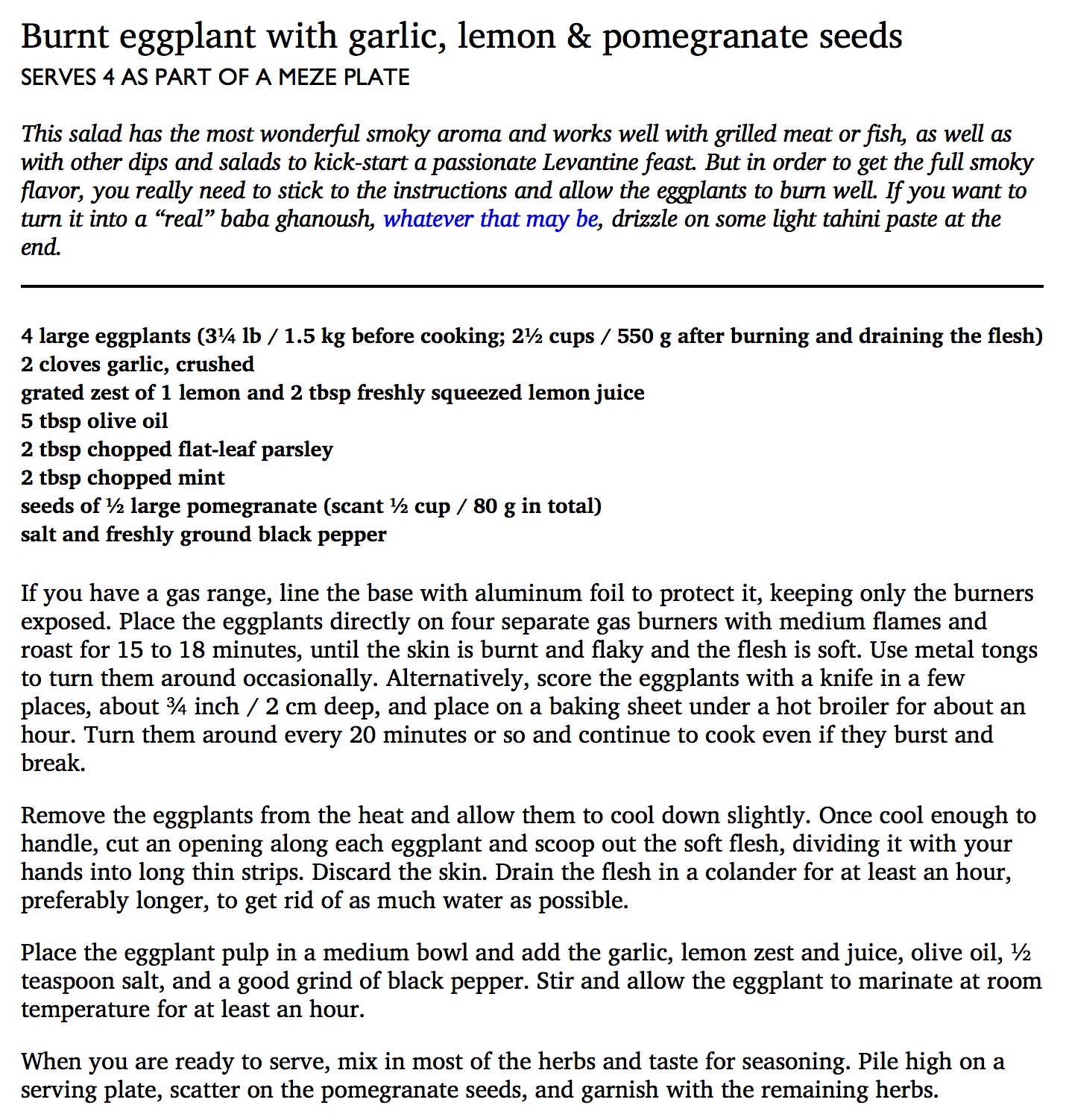how to approach a recipe to cook better
In my last post about how recipes are a terrible way to learn how to cook, I talked about using Jerusalem by Ottolenghi as an example in my second supper club.
Let's breakdown what I was reading in one of the simpler recipes, and I'll show you exactly what applicable concepts I'm taking away from it, beyond just the measurements.
Afterwards, I want you to try this with any recipe you desire. Let's get started.
the recipe

breakdown
For each section of the recipe, I will begin by zooming into the pieces that I want to break down.

This is just an overview of the recipe, some written context that Ottolenghi wants you to have. I read it only to get an essence of what to expect, especially if there are some cultural elements surrounding the dish that I'm uncertain of. I don't hang on every word and it's not supposed to be a section where I'm white knuckling it and setting myself up for failure. Enjoy the writing.

Here we go. These are the goodies. How annoyed are you when you start seeing the exact measurements for oil, herbs, and eggplant? I'm really annoyed. I totally ignore this stuff for now. At the very least, it doesn't tell me how much salt I need, which is somewhat positive.
While the exact measurements irk me, I still read them for broad strokes and balance, like I mentioned in the last post. Eggplant is obviously the main ingredient, and the rest of the ingredients are scattered in. Too many herbs and it'll be too floral. Too much pomegranate and it'll be like eating a minefield. Too much lemon and it'll be sour as fuck. Too much garlic and you'll be better off fighting vampires and whoever is in a 10-foot vicinity.
Just looking at the ingredient amounts alone, you should be able to discern that you're not going to flood the dish with herbs, oil or salt, or even pomegranate, right? You have an idea it's mostly going to be eggplant, studded with some pomegranates, interspersed with some herbs, and the fat n' acid will balance each other out. On top of that, season correctly, and the rest of the flavors do the job.
What else can you learn from just the ingredient list?
I can note that eggplant, olive, mint, parsley, and pomegranate offer a uniquely Mediterranean taste. This is after all, a Mediterranean cookbook. I understand this is a potentially disastrous assumption, based on the quality of the cookbook, and the reputation of the author. We'll address that later. For the time being, know that these are the ingredients they use, and once you know these general combinations, you can observe where these ingredients show up in other recipes and applications. Lamb with mint sauce, mint tea, and sardines scattered with parsley and olive oil are a few examples with just a small subset of ingredients that are uniquely Mediterranean.
Obviously, taste along the way, and you can reinforce where this "category" ends up on your palate, once you've finished cooking the recipe and are actually eating it. It's hard to describe, but you know that this eggplant is different as compared to Chinese eggplant, which is blasted with basil and high heat, and comes drenched in hoisin and soy sauce. Those are Asian flavors.
Let's move into the action portion of the recipe.

Burning the skin offers caramelization to the fullest extent, and layers a smoky flavor that can't be achieved with just simple roasting. The obvious thing heat also does here is cook. Hot temperatures break down the cell walls of the eggplant, rendering them soft. This is the desired texture of the dish. Scoring the eggplant is mostly for safety purposes, as you don't want a hot purple bomb ready to spit eggplant lava at you. Draining it helps to concentrate the flavor. Really, it's about a pasty soft texture, not watery-ass eggplant. This is flavor concentration.

The rest of the recipe is marination, flavor blending, and a combination of temperature and timing. Mixing the ingredients together is a pretty easy thing to understand, you want the different flavors and textures to come together.
Herbs will come at the end as to not cause severe oxidation, as you want the colors of the herbs to remain vibrant. The acid in the lemon zest and lemon juice should help to some extent, but if you decide to mix them in too early, there's the possibility that the greens lose their color.
Acid also comes in near the end, so you know how the acid balances the entire dish. Squeeze, mix, taste. Repeat until you like it.
Because the recipe sounds a lot like a warm salad, the serving time should be soon after finishing the recipe. I could imagine the oxidation process worsening if one decides to wait a day or two to serve. The eggplant will most likely dry out in this state and oxidize to some degree as well.
I'll re-iterate here that is it vitally important that at every stage, we think about singular flavor development and correct seasoning at each step, so that when we combine all the ingredients together, well seasoned components come together to make a well seasoned final dish.
final concept review
- the relative amount of each ingredient is important
- the absolute amount of each ingredient is less important
- flavor development and layering of singular components make or break a dish
- timing is essential
- seasoning at every stage
- taste, taste, taste
A quick note about that assumption I mentioned earlier. Recipes and recipe authors should be vetted. Who wrote the recipe? Were they qualified to write it? Are they at the very least, candid in the context of the recipe? Have they spent time in the ethnic culture and the day to day living in the local milieu? The stories they tell can be revealing. These are reputation factors that lend objectivity and confirmation of how much I believe what I'm reading.
Reputation or not, I will affirmatively say that the best way to experience a cuisine is to travel. Nothing beats local ingredients, local knowledge, and recipe stories straight from the mouth.
This is not the last recipe breakdown that I'll do, and because it's a relatively straightforward recipe, I felt it apropros to start with this one. Stay tuned for more, obviously. There's plenty to learn!
back to map of content (cooking)
